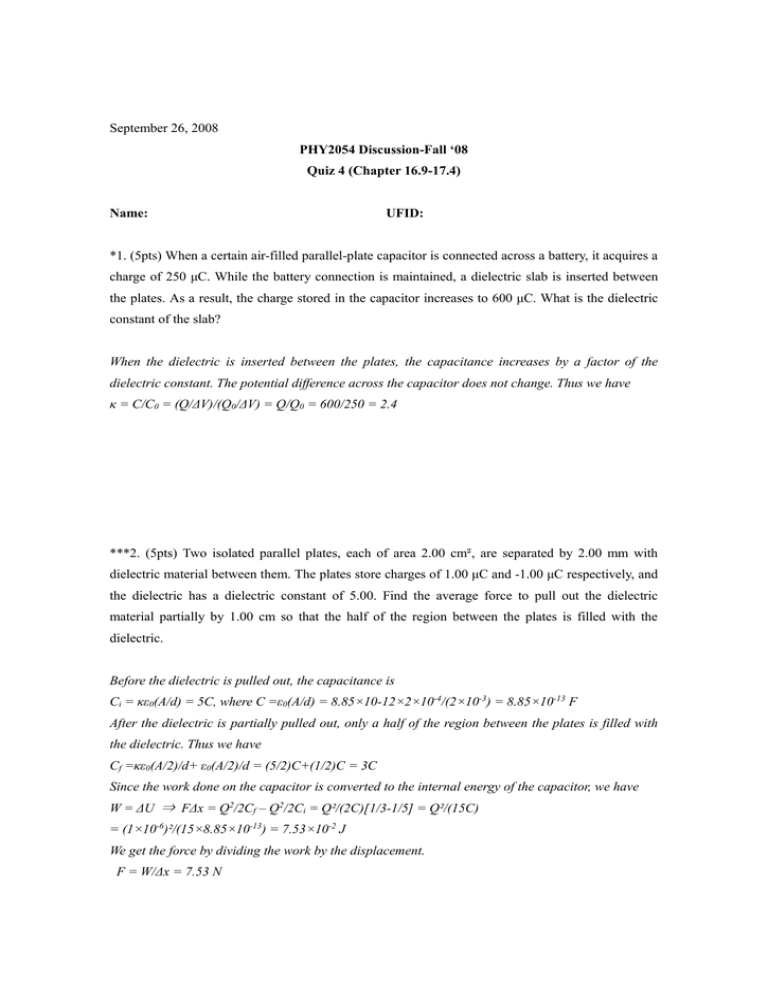September 26, 2008 PHY2054 Discussion-Fall ‘08 Quiz 4 (Chapter 16.9-17.4)
advertisement

September 26, 2008 PHY2054 Discussion-Fall ‘08 Quiz 4 (Chapter 16.9-17.4) Name: UFID: *1. (5pts) When a certain air-filled parallel-plate capacitor is connected across a battery, it acquires a charge of 250 μC. While the battery connection is maintained, a dielectric slab is inserted between the plates. As a result, the charge stored in the capacitor increases to 600 μC. What is the dielectric constant of the slab? When the dielectric is inserted between the plates, the capacitance increases by a factor of the dielectric constant. The potential difference across the capacitor does not change. Thus we have κ = C/C0 = (Q/ΔV)/(Q0/ΔV) = Q/Q0 = 600/250 = 2.4 ***2. (5pts) Two isolated parallel plates, each of area 2.00 cm², are separated by 2.00 mm with dielectric material between them. The plates store charges of 1.00 μC and -1.00 μC respectively, and the dielectric has a dielectric constant of 5.00. Find the average force to pull out the dielectric material partially by 1.00 cm so that the half of the region between the plates is filled with the dielectric. Before the dielectric is pulled out, the capacitance is Ci = κε0(A/d) = 5C, where C =ε0(A/d) = 8.85×10-12×2×10-4/(2×10-3) = 8.85×10-13 F After the dielectric is partially pulled out, only a half of the region between the plates is filled with the dielectric. Thus we have Cf =κε0(A/2)/d+ ε0(A/2)/d = (5/2)C+(1/2)C = 3C Since the work done on the capacitor is converted to the internal energy of the capacitor, we have W = ΔU ⇒ FΔx = Q2/2Cf – Q2/2Ci = Q²/(2C)[1/3-1/5] = Q²/(15C) = (1×10-6)²/(15×8.85×10-13) = 7.53×10-2 J We get the force by dividing the work by the displacement. F = W/Δx = 7.53 N Constants k = 8.99×109 Nm²/C² me = 9.11×10-31 kg 1 u = 1.66×10-27 kg ε0 = 8.85×10-12 C²/(Nm²) e = 1.6×10-19 C NA = 6.02×1023 mol-1 **3. (5pts) A copper wire carrying a current of 2.00 A has a cross sectional area of 5.00×10-6 m2. How long does it take one electron to travel 1.00 m of the wire? Copper has a density of 8.92×103 kg/m3, atomic mass of 63.5 u and molar mass of 63.5 g/mol. The mass of a copper nucleus is mc = 63.5u× 1.66×10-27kg/1u = 1.05×10-25 kg The number density of free electrons is the same as that of copper nucleus. n = density/mc =8.92×103/ 1.05×10-25 = 8.50×1028 /m3 The drift speed of the electrons is vd = I/(nqA) = 2/(8.5×1028×1.6×10-19×5×10-6)= 2.94×10-5 m/s Since displacement is given by velocity times time, we have Δt = Δx/vd = 1/(2.94×10-5) = 3.40×104 s = 9.44 h *4. (5pts) A flashlight bulb operating at a voltage of 1.50 V has a resistance of 5.00 Ω. How many electrons pass through the bulb filament per minute? The current in the lightbulb is I = ΔV/R = 1.5/5 = 0.300 A Since current is defined as an amount of charge passing a cross section in one second, the charge passing through the lightbulb in one minute is ΔQ = IΔt = 0.3×60 = 18.0 C Dividing the total charge by the electronic charge, we have N = ΔQ/e = 18/(1.6×10-19) = 1.13×1020 electrons



